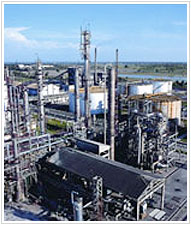|
|
Chemical processing
To inert vessels and oxygen-sensitive chemicals, creating
an oxygen-deficient environment that reduces safety hazards;
to propel liquids through pipelines; and to manufacture
ammonia. |
|
|
Concrete cooling
To keep ready mixed concrete at the temperature needed
to meet critical specifications. |
|
|
Construction
To suppress the pour temperature of concrete mixtures,
inhibiting the formation of cracks; and to stabilise the
ground as in the restoration of the Leaning Tower of Pisa. |
|
|
Electronics
To prevent oxidation in the manufacture of semiconductors
and printed circuits; and to enhance solvent recovery
systems by eliminating the use of chlorofluorocarbons
for cleanup. |
|
|
Food
To extend shelf-life in packaged foods by preventing spoilage
from oxidation, mould growth, moisture migration and insect
infestation; to rapidly freeze and refrigerate perishables
during transport. |
|
|
Glass manufacturing
To cool furnace electrodes and prevent oxidation during
manufacturing; and to lower air temperatures for optimum
cooling rates. |
|
|
Metal production and fabrication
To protect metals such as steel, copper and aluminium
during annealing, carburising and sintering operations
in high temperature furnaces; to cool extrusion dies;
and to shrink fit metal parts; utilised as a purge gas
with stainless steel tube welding. Also used to support
plasma cutting. |
|
|
Miscellaneous
Nitrogen's low boiling point and non-toxic properties
make it an economical choice for recycling tyres through
cryopulverisation. In this process, liquid nitrogen serves
as a freezing agent and embrittles shredded tyre scrap
so that it can be easily ground into crumb rubber. The
resulting product finds use in roofing materials, sealants,
oil well linings, recreational surfaces and asphalt paving.
A similar process is used to grind and sort polyvinyl
chloride from post-consumer scrap in mixed waste loads,
as well as to grind and process dried fruits, delicate
herbs and spices. |
|
|
Petroleum recovery and refining
To improve recovery and maintain pressure in oil and gas
reservoirs; to blanket storage tanks and product loading/unloading;
to purge pipelines; and to strip volatile organic compounds
(VOCs) from waste streams or to cool vent streams. Controlling
VOC emissions helps refiners. |
|
|
Research and health services
To freeze and preserve blood, tissue, semen and other
biological specimens; to freeze and destroy diseased tissue
in cryosurgery and dermatology; and to pre-cool or insulate
Magnetic Resonance Imaging (MRI), conserving the more
expensive helium. |


